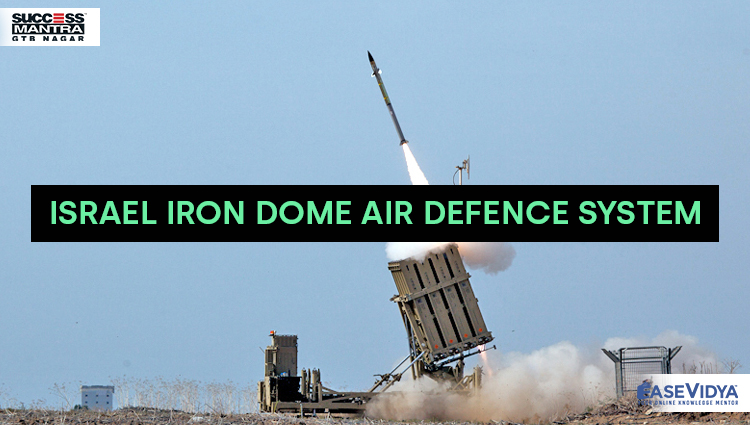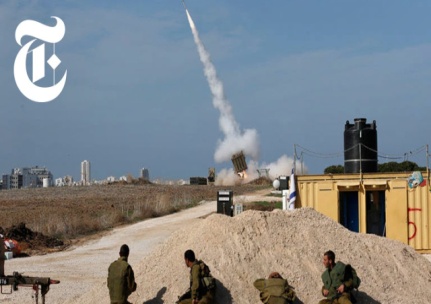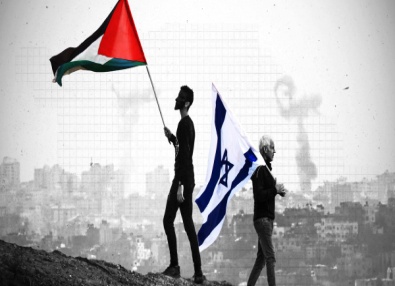
ISRAEL IRON DOME AIR DEFENCE SYSTEM
ISRAEL IRON DOME AIR DEFENCE SYSTEM

Israel used its Iron Dome air defence system in recent violent clashes over Jerusalem. It is a short-range, ground-to-air, air defence system that includes a radar and Tamir interceptor missiles that track and neutralise any rockets or missiles aimed at Israeli targets. It is used for countering rockets, artillery & mortars as well as aircraft, helicopters and Unmanned Aerial Vehicles (UAV). It is capable of being used in all weather conditions, including during the day and night. It was developed by the state-run Rafael Advanced Defense Systems and Israel Aerospace Industries and was deployed in 2011. Rafael claims a success rate of over 90%, with more than 2,000 interceptions, however experts agree the success rate is over 80%. It can protect deployed and manoeuvring forces, as well as the Forward Operating Base (FOB) and urban areas, against a wide range of indirect and aerial threats.
COMPONENTS OF THE IRON DOME SYSTEM
The Iron Dome has three main systems that work together to provide a shield over the area where it is deployed which are:
- Radar: It has a detection and tracking radar to spot any incoming threats.
- Weapon Control: It has a battle management and weapon control system (BMC),
- Missile Fire: It also has a missile firing unit. The BMC basically liaises between the rIadar and the interceptor missile.
INDIAN ALTERNATIVES
S-400 TRIUMF: India has S-400 TRIUMF, which also caters to the three threats (rockets, missiles and cruise missiles). But they have much longer range. It has a much larger air defence bubble to knock off threats. It is a mobile, surface-to-air missile system (SAM) designed by Russia. The system can engage all types of aerial targets within the range of 400km, at an altitude of up to 30km. The system can track 100 airborne targets and engage six of them simultaneously.
Prithvi Air Defence and Advance Air Defence: It is a double-tiered system consisting of two land and sea-based interceptor missiles, namely the Prithvi Air Defence (PAD) missile for high altitude interception, and the Advanced Air Defence (AAD) Missile for lower altitude interception. It is able to intercept any incoming missile launched 5,000 kilometres away. The system also includes an overlapping network of early warning and tracking radars, as well as command and control posts.
Ashwin Advanced Air Defence Interceptor Missile: It is also an indigenously produced Advanced Air Defence (AAD) interceptor missile developed by Defence Research and Development Organisation (DRDO). It is the advanced version of the low altitude supersonic ballistic interceptor missile. The missile also has its own mobile launcher, secure data link for interception, independent tracking and homing capabilities and sophisticated radars. It uses an endo-spheric (within the Earth’s atmosphere) interceptor that knocks out ballistic missiles at a maximum altitude of 60,000 to 100,000 feet, and across a range between 90 and 125 miles
BACKGROUND: TERRITORIAL PUZZLE

West Bank: The West Bank is sandwiched between Israel and Jordan. One of its major cities is Ramallah, the de facto administrative capital of Palestine. Israel took control of it in the 1967 war and has over the years established settlements there.
Gaza: The Gaza Strip located between Israel and Egypt. Israel occupied the strip after 1967, but relinquished control of Gaza City and day-to-day administration in most of the territory during the Oslo peace process. In 2005, Israel unilaterally removed Jewish settlements from the territory, though it continues to control international access to it.
Golan Heights: The Golan Heights is a strategic plateau that Israel captured from Syria in the 1967 war. Israel effectively annexed the territory in 1981. Recently, the USA has officially recognized Jerusalem and Golan Heights a part of Israel.
Palestinian Authority- Created by the 1993 Olso Accords, it is the official governing body of the Palestinian people, led by President Mahmoud Abbas of the Fatah faction. Hobbled by corruption and by political infighting, the PA has failed to become the stable negotiating partner its creators had hoped.
Fatah- Founded by the late Yasir Arafat in the 1950s, Fatah is the largest Palestinian political faction. Unlike Hamas, Fatah is a secular movement, has nominally recognized Israel, and has actively participated in the peace process.
Hamas- Hamas is regarded as a terrorist organization by the U.S. government. In 2006, Hamas won the Palestinian Authority's legislative elections. It ejected Fatah from Gaza in 2007, splitting the Palestinian movement geographically, as well.
THE TWO STATE SOLUTION: ISRAEL & PALESTINE
The “two state solution” is based on a UN resolution of 1947 which proposed two states - one would be a state where Zionist Jews constituted a majority, the other where the Palestinian Arabs would be a majority of the population. The idea was however rejected by the Arabs. For decades, it has been held by the international community as the only realistic deal to end the Israeli-Palestinian conflict.
Borders: There is no consensus about precisely where to draw the line – with Israel building settlements and constructing barriers in areas like the West Bank that creates a de facto border. This makes it difficult to establish that land as part of an independent Palestine, breaking it up into non-contiguous pieces.
Jerusalem: Both sides claim Jerusalem as their capital and consider it a center of religious worship and cultural heritage making its division difficult.
In December 2017, Israel declared Jerusalem as its capital and the step found support from the USA, intensifying the situation in the region.
Refugees: Large numbers of Palestinians who fled their homes in what is now Israel, during the preceding wars as well as their descendants believe they deserve the right to return but Israel is against it.
Divided Political Leadership on Both sides: The Palestinian leadership is divided - two-state solution is supported by Palestinian nationalists in West Bank but the leadership in Gaza does not even recognize Israel. Further, while successive Israeli Prime Ministers - Ehud Barak, Ariel Sharon, Ehud Olmert and Benjamin Netanyahu - have all accepted the idea of a Palestinian state, they have differed in terms of what it should actually comprise.
TEST YOURSELF
Q.1 Which of the following countries/nation recently uses the Iron Dome Air Defence System in a recent clash over its Capital city?
- Israel: ANSWER
- United states of America
- Palestine
- Jordan
Q.2 Which of the following given statements is/are correct in the reference to the Iron Dome Air Defence System?
- It is a short-range, ground-to-air, air defence system that includes a radar and Tamir interceptor missiles that track and neutralise any rockets or missiles aimed at Israeli targets.
- It is used for countering rockets, artillery & mortars as well as aircraft, helicopters and Unmanned Aerial Vehicles (UAV).
- Only I follows
- Only II follows
- Both I & II follows: ANSWER
- None of the above
Q.3 ___________ is a double-tiered system consisting of two land and sea-based interceptor missiles, namely the PAD missile for high altitude interception, and the AAD Missile for lower altitude interception?
- S-400 TRIUMF
- Prithvi Air Defence and Advance Air Defence: ANSWER
- Ashwin Advanced Air Defence Interceptor Missile
- None of the above
Q.4 Consider the following statements & state which of the following is incorrect in the context of above-mentioned passage?
- The West Bank is sandwiched between Israel and Palestine: ANSWER
- The Golan Heights is a strategic plateau that Israel captured from Syria in the 1967 war.
- Hamas is regarded as a terrorist organization by the U.S. government in 2006, Hamas won the Palestinian Authority's legislative elections.
- None of the above
Q.5 Which of the following two countries claim Jerusalem as their capital and consider it a center of religious worship and cultural heritage making its division difficult?
- Palestine & Jordan
- Israel & Palestine: ANSWER
- Palestine & Jordan
- None of the above












0 Comment